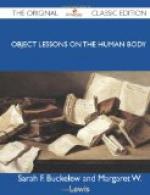My teeth are made of a soft kind of bone, covered with enamel.
I have three kinds of teeth: cutting teeth, tearing teeth, grinding teeth.
A young child has twenty teeth, ten in each jaw.
A grown person has thirty-two teeth, sixteen in each jaw.
6. To preserve my teeth:
I must keep them clean.
I must not scratch the enamel.
I must not eat or drink anything very
hot or very cold.
I must not use them for scissors or nut-crackers.
I must not burn them with tobacco or cigars.
7. About Eating.—When I eat I move my lower jaw only.
My tongue brings the food between my teeth, the cutters cut it, the tearers tear it, the grinders grind it, the saliva moistens it, and my tongue helps me to swallow it.
* * * * *
QUESTIONS FOR THE FORMULAS.
1. Tell about your eyes.
2. Tell about your ears.
3. Tell about your nose.
4. Tell about your mouth.
5. Tell about your teeth.
6. What is necessary if you would preserve your teeth?
7. Tell about eating.
* * * * *
[Illustration
1, the muscle which raises the upper eyelid.
2, the upper oblique muscle.
7, the lower oblique muscle. The
oblique muscles roll the eye
inward and downward.
4, 5, 6, three of the four straight
muscles. Two of the straight
muscles roll the eye up and
down; the other two move it right and left.
3, the pulley through which the upper
oblique muscle plays.]
* * * * *
QUESTIONS ON THE DESCRIPTION OF THE EYES.
Of what shape is the eye?—“It is round like a ball.”
In what is it placed?—“In a deep, bony socket.”
What is a socket?—“A hollow place.”
Why is the eye placed in a deep, bony socket?—“To keep it from getting hurt.”
Why would not an eye shaped like a cube do for us?—“It would not look well; it could not be rolled about.”
Why would not an eye shaped like a cone or cylinder do for us?—“It could not be rolled in every direction.”
Why is the ball-shape best for the eye?—“It looks best, and may be rolled in every direction.”
What part of the eye do we see through?—“The black spot in the centre.”
What is it called?—“The pupil.”
What shape is the pupil?—“Round like a circle.”
What color is the pupil?—“Black.”
Of what use is the pupil?—“To let light into the eye; to see through.”
What is around the pupil?—“A colored ring.”
What is the colored ring called?—“The iris.”
Of what use is the iris?—“It acts like a curtain to the eye; it lets in and keeps out light from the pupil.”
Of what shape is the iris?—“Round like a ring.”




